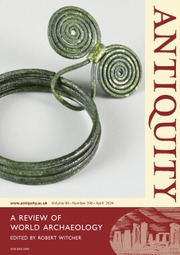Article contents
The ‘microliths’ from the Isles of Scilly and the continental Mesolithic: similar yet still so different
Published online by Cambridge University Press: 06 August 2015
Extract
There is little doubt that the small lithic assemblage from the Isles of Scilly is totally different to that from any other Mesolithic site in Britain. As the authors correctly state, the general resemblances to trapeze-dominated assemblages from the continent, in particular to the Late and Final Mesolithic industries from northern France, Belgium and the southern Netherlands, are very obvious. Typologically, the majority of armatures relate to continental rhombic trapezes, called ‘trapèzes à bases décalées’. Upon closer examination, however, several armatures display morphological or technical features that deviate from continental trapezes, making the Scilly assemblage both unique and enigmatic within north-west Europe. In particular, the presence of a dorsally or ventrally retouched base between both truncations on at least 20 of the armatures (p. 962, fig. 5) is remarkable. This is a feature that does not occur on continental trapezes, not even on the evolved rhombic trapezes known as flèches de Dreuil. The latter are particularly numerous in assemblages from the Somme valley (Ducrocq 1991), near the coast where the Channel crossing is narrowest. The combination of a length–width ratio typically <1 and the general use of flakes as blanks prompts us to interpret these implements as transverse arrowheads rather than standard trapezes. Pursuing this interpretation, the basal retouch might have been applied in order to facilitate their hafting, while the irregular small ‘splinters’ on the unretouched opposite end, visible on several of the drawings, might correspond to damage resulting from use.
Information
- Type
- Debate
- Information
- Copyright
- Copyright © Antiquity Publications Ltd, 2015
References
- 2
- Cited by

